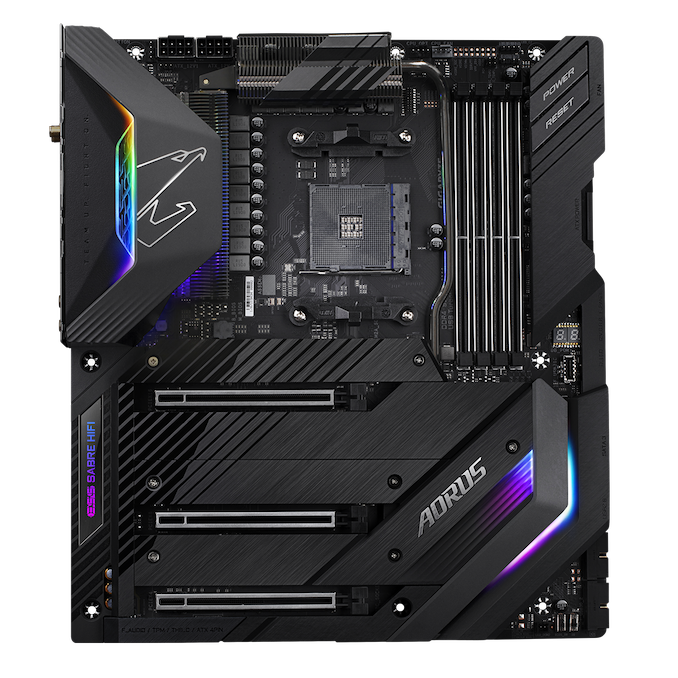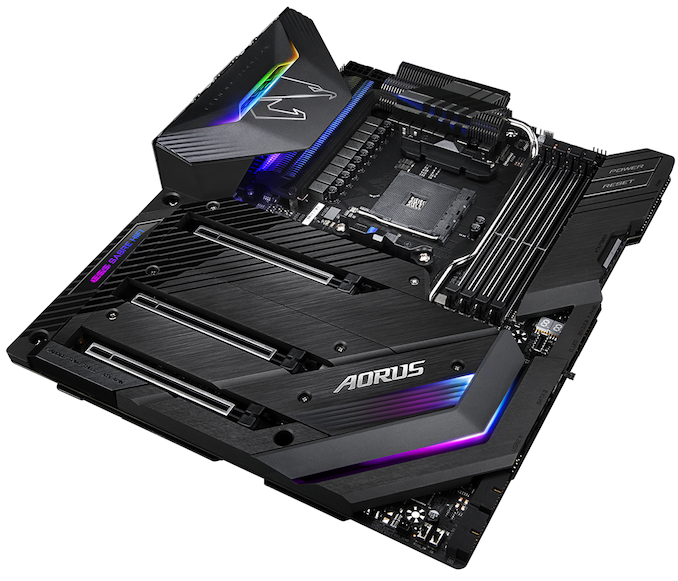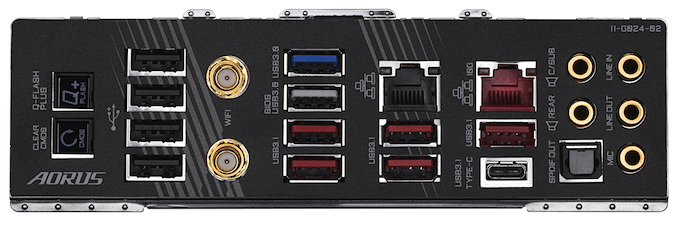The AMD X570 Motherboard Overview: Over 35+ Motherboards Analyzed
by Gavin Bonshor on July 9, 2019 8:00 AM ESTGIGABYTE X570 Aorus Xtreme
Moving onto GIGABYTE's launch day X570 product stack, and it seems to have upped the ante in a number of areas over the previous X470 generation of motherboards. Firstly, GIGABYTE has done a slightly different approach with its power delivery configurations; on paper, they look much higher spec than on previous AM4 models. One prime example of this is in the GIGABYTE X570 Aorus Xtreme which as it stands, is the brand's current flagship model, and is feature-packed with numerous premium componentry, as well as a beefy 16-phase power delivery for the CPU. The other unique feature for the X570 Aorus Xtreme is it's currently the only X570 model at launch to passively cool the warm running X570 chipset.
The X570 Aorus Xtreme is the current flagship from GIGABYTE with a large looking 16-phase power delivery for users looking to overclock the latest Ryzen 3000 series processors, as well as a solid high-end feature set. Across the majority of the PCB, we get Aorus themed armor with three PCIe 4.0 x4 M.2 slots each with its own heatsink which moulds into the PCB cover. There are also six SATA ports with support for RAID 0, 1 and 10 arrays. The CPU VCore section of the power delivery uses two 8-pin 12 V CPU power inputs to deliver power to the processor.
The chipset heatsink onboard the X570 Aorus Xtreme is also one of the only models so far that relies on passive cooling which is interesting as we know the X570 chipset will run with two variants, an 11 W and 15 W. On the rear panel cover is an Aorus Falcon design, with multiple areas with RGB LEDs that users can customize with the Aorus RGB Fusion software. In the top right-hand corner is a power and reset switch, with a small debug LED, and front panel USB 3.1 G2 Type-C port. There are three full-length PCIe 4.0 slots with no PCIe 4.0 x1 slots featured on this model. One of the aspects GIGABYTE is known for focusing on with its high-end models is the onboard audio solution. Adding to the implementation of a Realtek ALC1220 HD audio codec is an ESS Sabre 9218 DAC, with WIMA audio capacitors.
On the rear panel is a large number of inputs and outputs which includes five USB 3.1 G2 Type-A, one USB 3.1 G2 Type-C, two USB 3.1 G1 Type-A, and four USB 2.0 ports. There are two antenna connectors for the integrated Intel AX200 Wi-Fi 6 802.11ax wireless interface, as well as two Ethernet ports which are powered by an Aquantia AQC107 10 G, and Intel I211-AT Gigabit NIC pairing. The Realtek ALC1220-VB HD audio codec adds five 3.5 mm audio jacks and an S/PDIF optical output. Also featured is a clear CMOS switch and Q-Flash Plus BIOS flashing button.
The GIGABYTE X570 Aorus Xtreme is a fine example of what vendors can do for its flagship models on the X570 chipset with plenty of USB 3.1 G2 ports on the rear panel. Dual networking with a 10 G NIC, Wi-Fi 6 capability, and 16-phase power delivery for the CPU make the X570 Aorus Xtreme very attractive. This model has an MSRP of $699 which represents the top end of the X570 product stack at launch, but with everything on offer, it was always expected to be expensive.













225 Comments
View All Comments
sorten - Tuesday, July 9, 2019 - link
Good advice, and you get lower system power consumption as a bonus. The main reason to go with the more expensive x570 boards is PCIE 4.0, and you're not going to get that if you switch to Intel.Ratman6161 - Tuesday, July 9, 2019 - link
Asrock has the x570 pro 4 listed on their web site with an MSRP of $154.00 I've used their Pro X boards in a number of builds and always had good results with them. They don't seem to be available at retail yet (at least anywhere I've seen) . On the other hand, I'm not one of those to go out and buy any product on the first day. Street prices on both motherboards and CPU's are likely to drop quickly and...even if I go out and buy a new CPU, I don't have anything else that could take advantage of the x570 chipset for the time being, so my x470 is probably good to go for quite some time to come anyway.Gastec - Wednesday, July 10, 2019 - link
Ryzen 3000 series CPU prices are going to be over MSRP for at least 3 months.Targon - Thursday, July 11, 2019 - link
I don't know where you live, but here in the USA, the CPUs are all at the official prices, unless you go to a third party seller who is trying to scam money out of people. Note that many online stores show products from third parties in addition to what they sell themselves, so when you see CPU prices above MSRP, those are the third party scammers.Newegg is getting daily deliveries by the look of it, and I expect the other large online sources are as well. The sales volumes are high on these chips, and some people just take advantage of it and charge more money.
Gastec - Saturday, July 13, 2019 - link
On Amazon.es and PCComponentes.com the EXACT SAME price, set up by bots:AMD Ryzen 9 3900X, 548,90€
AMD Ryzen 7 3700X: 361,80 €
eva02langley - Tuesday, July 9, 2019 - link
The only reason to buy x570 is for PCIe 4.0. If you don't need it, get a B450 board at 75$ Will work for every Ryzen 3000 CPUs.I am even thinking about using my X370 MSI Gaming Pro Carbon for my 3950x.
abufrejoval - Tuesday, July 9, 2019 - link
Unless you happen to have an older Ryzen or Carrizo lying around, there could be a problem to get older boards with an up-to-date BIOS.Had similar issues a year ago when RAM was so expensive, I had to recycle DDR3 for Kaby Lake CPUs using Z170 motherboards that only has Skylake support. Sandy Bridge, Ivy Bridge and Haswell CPUs I had galore, but Skylake only as notebooks. I wound up buying a Sky Lake i3, which I then returned for a full refund after I had updated the motherboards.
Didn't feel good about it, wasn't given a choice either.
These days some dealers offer a BIOS upgrade service, but at €40 it pretty much eats the 3. + 4. generation benefit.
I want 10Gbase-T or rather NBase-T. Currently that means mostly Aquantia 107, of which I have 4 already. Those are €88 a piece, but when I look at these x570 prices, they charge a 300% premium for what's essentially a low-cost chip.
And then I hear rumors, that there is actually 10Gbit Ethernet or in fact 100Gbit Ethernet already on-die, both in the CPU chiplet and the x570 chipset variant: For IF Ethernet is simply another protocol to run on the fabric and all you need is PHY.
It is rather unfortunate that sane CPU prices, sane SSDs and sane RAM only mean that motherboard vendors are hoping to cash in big-time.
I can see how they would be hungry. But I don't have 'waste money' around to feed them.
The_Assimilator - Wednesday, July 10, 2019 - link
Asus boards have a "BIOS flashback" feature whereby if you plug in a flash drive with a new BIOS to a specific USB port and press a button on the IO panel, the board will auto-flash itself with that BIOS - no CPU is needed, just power to the board.Targon - Thursday, July 11, 2019 - link
Almost all MSI motherboards have BIOS flashback, and the Asus ROG Crosshair series also has BIOS flashback where you don't need a CPU or RAM in order to flash the BIOS. Most Asus motherboards do NOT have BIOS flashback capability.DanNeely - Tuesday, July 9, 2019 - link
when they get PCI4 support Intel's boards will be equally more expensive than the previous generation. Maintaining that high frequency a signal across more than a cm or 2 requires building boards to a much higher and more expensive standard or active signal booster chips along the path.PCIe 5 will be far worse on that front. Estimates I saw earlier this year were that PCIe4 would add as much as $100 to the price of a board; with the cheapest x570 boards being almost $100 more than the cheapest x470's on Newegg and the average (excluding the crazy halo ones) looking like it's at least $50 higher that doesn't seem too far off. That article (ee times asia???) was predicting that PCIe5 could end up adding as much as $400 above the cost of a 3.0 capable board; which if true probably means it will end up server only or with only a narrow strip between the CPU and chipset build up to that standard. (Assuming the latter possible anyway: If the cost challenge is more preventing external interference than in needing higher quality materials a local board segment fudge might not be feasible.)